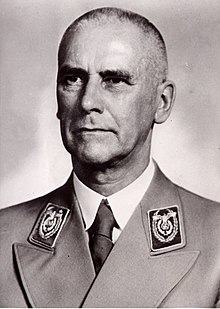
Back Wilhelm Frick Afrikaans فيلهلم فريك Arabic ويلهم فريك ARZ Вільгельм Фрык Byelorussian Вилхелм Фрик Bulgarian Wilhelm Frick BS Wilhelm Frick Catalan Wilhelm Frick Czech Wilhelm Frick Danish Wilhelm Frick German
Wilhelm Frick | |
|---|---|
 Wilhelm Frick, c. 1940-45 | |
| Reichsminister of the Interior | |
| In office 30 January 1933 – 20 August 1943 | |
| President | Paul von Hindenburg (1933–1934) Adolf Hitler (1934–1943; as Führer) |
| Chancellor | Adolf Hitler |
| Preceded by | Franz Bracht |
| Succeeded by | Heinrich Himmler |
| General Plenipotentiary for Administration of the Reich | |
| In office 4 September 1938[1] – 20 August 1943 | |
| Appointed by | Adolf Hitler |
| Preceded by | Office established |
| Succeeded by | Heinrich Himmler[2] |
| Protector of Bohemia and Moravia | |
| In office 24 August 1943 – 8 May 1945 | |
| Appointed by | Adolf Hitler |
| Preceded by | Konstantin von Neurath (de jure) Kurt Daluege (de facto) |
| Succeeded by | Position abolished |
| Reichsminister without Portfolio | |
| In office 24 August 1943 – 30 April 1945 | |
| Additional positions | |
| 1939–1945 | Member of the Council of Ministers for the Defense of the Reich |
| 1934—1945 | Member of the Prussian State Council |
| 1933—1945 | Reichsleiter |
| 1933–1945 | Member of the Reichstag (Nazi Germany) |
| 1924—1933 | Member of the Reichstag (Weimar Republic) |
| Personal details | |
| Born | 12 March 1877 Alsenz, Kingdom of Bavaria, German Empire |
| Died | 16 October 1946 (aged 69) Nuremberg Prison, Nuremberg, Bavaria, Allied-occupied Germany |
| Cause of death | Execution by hanging |
| Political party | Nazi Party |
| Spouses |
|
| Children | 5 |
| Alma mater | |
| Occupation | Attorney |
| Signature |  |
| Criminal conviction | |
| Criminal status | Executed |
| Conviction(s) | Crimes of aggression War crimes Crimes against humanity |
| Trial | Nuremberg trials |
| Criminal penalty | Death |
Wilhelm Frick (12 March 1877 – 16 October 1946) was a convicted war criminal and prominent German politician of the Nazi Party (NSDAP) who served as Minister of the Interior in Adolf Hitler's cabinet from 1933 to 1943[3] and as the last governor of the Protectorate of Bohemia and Moravia.
As the head of the Kriminalpolizei (criminal police) in Munich, Frick took part in Hitler's failed Beer Hall Putsch of 1923, for which he was convicted of high treason. He managed to avoid imprisonment and soon afterwards became a leading figure of the Nazi Party (NSDAP) in the Reichstag. After Hitler became Chancellor of Germany in 1933, Frick joined the new government and was named Minister of the Interior. Additionally, on 21 May 1935, Frick was named Generalbevollmächtigter für die Reichsverwaltung (General Plenipotentiary for the Administration of the Reich).[4] He was instrumental in formulating laws that consolidated the Nazi regime (Gleichschaltung), as well as laws that defined the Nazi racial policy, most notoriously the Nuremberg Laws. On 30 August 1939, immediately prior to the outbreak of the Second World War, Frick was appointed by Hitler to the six-person Council of Ministers for Defense of the Reich which operated as a war cabinet.[5] Following the rise of the SS, Frick gradually lost favour within the party, and in 1943 he was replaced by Heinrich Himmler as interior minister. Frick remained in the cabinet as a minister without portfolio until Hitler's death in 1945.
After World War II, Frick was tried and convicted of war crimes at the Nuremberg trials and executed by hanging.
- ^ Office of United States Counsel for Prosecution of Axis Criminality (1948). Nazi Conspiracy And Aggression: Supplement B. United States Government Printing Office. p. 408.
- ^ Lisciotto, Carmelo (2007). "SS & Other Nazi Leaders". Holocaust Research Project. Retrieved 18 April 2024.
- ^ Claudia Koonz, The Nazi Conscience, p 103, ISBN 0-674-01172-4
- ^ "Nazi Germany - Government Structure". Retrieved 8 May 2023.
- ^ Broszat, Martin (1981). The Hitler State. Longman Inc. pp. 308–309. ISBN 0-582-49200-9.
© MMXXIII Rich X Search. We shall prevail. All rights reserved. Rich X Search